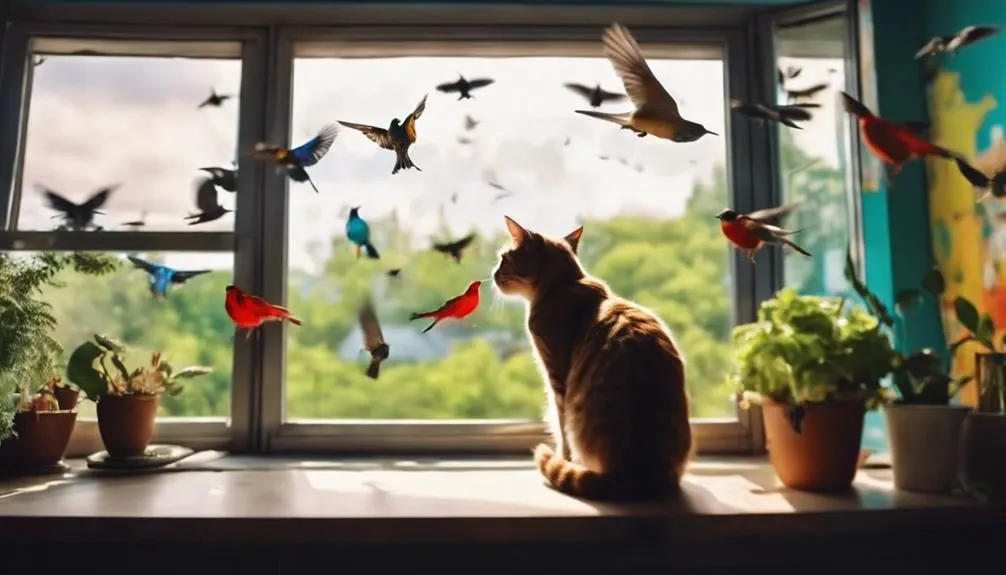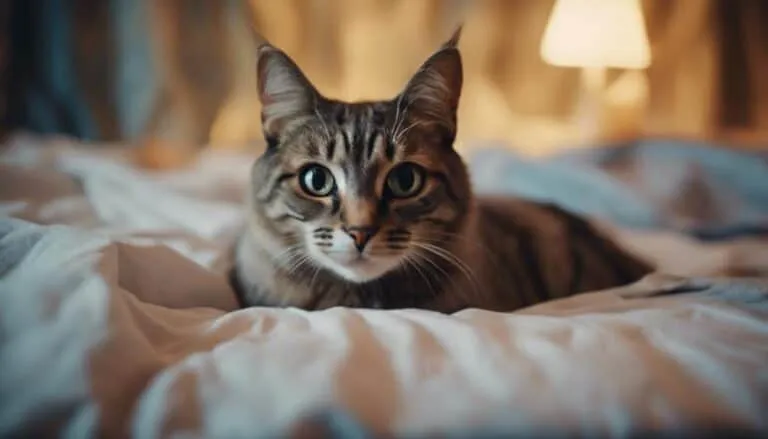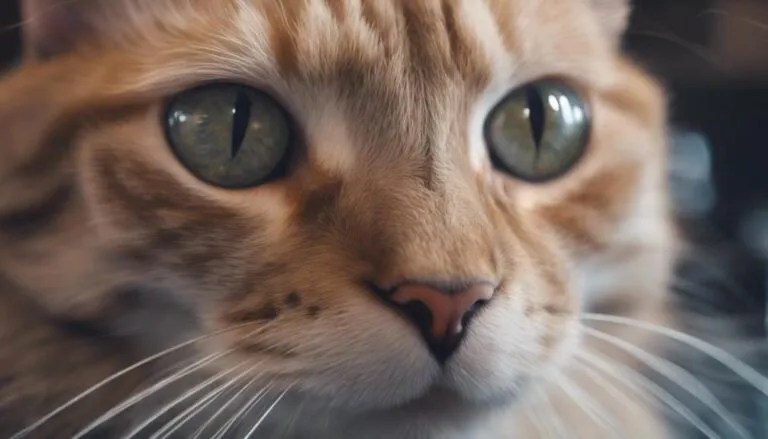The Best Fluffy Pancakes recipe you will fall in love with. Full of tips and tricks to help you make the best pancakes.

You might be surprised to learn that cats' vision is not just a slight variation of human eyesight.
Have you ever wondered how their visual perception shapes their understanding of the world around them?
Understanding how cats see the world from a feline perspective can offer intriguing insights into their behavior and interactions with their environment.
Their unique visual abilities shed light on how they navigate, hunt, and communicate in ways that differ from our own experiences.
Explore the intriguing world of feline vision to uncover the mysteries behind their captivating gaze.
Key Takeaways
- Cats have superior night vision due to specialized eye structures and adaptations.
- Cats' color perception focuses on motion and contrast for effective hunting strategies.
- Cats possess wide peripheral vision and acute motion detection skills for hunting success.
- Cats' evolved visual acuity aids in precise movements and efficient hunting techniques.
Visual Perception of Cats
Cats possess exceptional visual abilities that significantly differ from humans, allowing them to perceive the world uniquely. Their vision is a vital tool for survival and hunting. Cats have eyes that grant them a visual field of about 200 degrees, wider than humans, enhancing their peripheral vision. Despite having lower visual acuity than humans, cats can see objects clearly up to around 20 feet away. Their eyes contain photoreceptor cells called rods, abundant in their retinas, which enable them to excel in seeing in dim light environments.
Regarding color vision, cats have a limited spectrum compared to humans. They're sensitive to blue-violet and greenish-yellow ranges, affecting how they differentiate colors. This unique color perception influences how cats interact with their surroundings. Furthermore, their night vision capabilities are exceptional due to the abundance of rod cells. This specialized adaptation allows cats to navigate and hunt efficiently in low-light conditions, making them formidable nocturnal predators.
Night Vision Capabilities
Cats possess remarkable night vision capabilities that enable them to see in low light conditions with exceptional clarity. Their tapetum layer reflects light, enhancing their vision in the dark.
Due to their elliptical pupils that dilate in dim light, cats can efficiently hunt at night by allowing more light to enter their eyes for improved visibility.
Night Vision Mechanics
With their highly specialized ocular structures, felines possess remarkable night vision capabilities that far surpass those of humans. Cats' ability to see clearly in low light conditions is due to the following night vision mechanics:
- The tapetum behind cats' retinas reflects light back to the photoreceptor cells, enhancing their vision in the dark.
- Cats' elliptical pupils adapt to low light conditions, allowing more light to enter the eye and improving night vision efficiency.
- The tapetum lucidum in cats' eyes not only gives them their characteristic glowing eyes but also aids in night vision by reflecting light and maximizing their ability to see in the dark.
Adaptations for Darkness
Enhancing their ability to navigate and hunt in low light conditions, felines possess specialized adaptations for darkness that significantly improve their night vision capabilities. Cats have a mirror-like layer called the tapetum behind their retinas, reflecting light back to the photoreceptors, aiding in seeing in dim light.
With six times better vision in low light compared to humans, cats require less light to see clearly due to their high number of rod cells in the retina, which are sensitive to dim light. The tapetum lucidum further enhances their night vision by reflecting light, causing their eyes to appear to glow in the dark.
This superior night vision allows cats to perceive movements imperceptible to humans, enabling effective navigation and hunting in dark environments.
Color Vision in Cats
Color vision in cats is limited compared to humans, impacting their perception of the world around them. Cats have two photopigment receptors, while humans have three, which affects their ability to distinguish colors. This limitation in color acuity results in cats primarily seeing in shades of gray, blue, and yellow, with difficulty in perceiving vibrant colors like reds and oranges. Their vision is adapted for hunting, emphasizing the detection of motion and contrast rather than focusing on vibrant colors. Cats' color perception is akin to that of color-blind humans, shaping how they interpret their surroundings.
Cats have two photopigment receptors, unlike humans who've three, affecting their color perception.
Cats primarily see in shades of gray, blue, and yellow, lacking the ability to distinguish vibrant colors like reds and oranges.
Cats' vision is adapted for hunting, prioritizing the detection of motion and contrast over vibrant colors.
Acuity and Focus
Cats exhibit lower visual acuity compared to humans, enabling them to see objects sharply at closer ranges up to 20 feet. Feline eyes are designed with a higher concentration of rod cells, specialized for low-light conditions, sacrificing detailed vision and color perception. This unique adaptation allows cats to excel in capturing fast movements efficiently. The abundance of rod cells in their retinas contributes to their exceptional night vision capabilities. While cats may not see fine details as clearly as humans do, their visual acuity compensates by providing a broader visual field, enhancing their overall hunting and tracking abilities.
Unlike humans, cats have a structure called the tapetum in their eyes, which reflects light back through the retina, giving them better night vision. This reflective layer enhances their ability to see in low-light environments but can also cause the glowing eyes effect commonly seen in the dark. Cats' eyes are finely tuned for detecting movement and capturing prey, making them efficient hunters even in dimly lit conditions.
Peripheral Vision
Cats have a wide visual range of 200 degrees, providing them with the ability to detect movement easily. Their 30 degrees of peripheral vision on each side surpasses that of humans, aiding in their awareness of potential threats or prey.
However, this wider field comes at the cost of limited depth perception.
Wide Visual Range
With their wide visual range, cats possess an impressive peripheral vision that surpasses that of humans in detecting movement and potential threats. Cats enjoy a visual field of approximately 200 degrees, wider than humans' 180 degrees, allowing for better peripheral vision.
This wider scope enables cats to spot prey or predators from various angles, enhancing their hunting abilities significantly. Moreover, with 30 degrees of peripheral vision on each side, cats can detect movement and potential threats efficiently, ensuring their awareness of the environment.
The expanded peripheral vision of cats, represented by blurry edges in visualizations, showcases their evolutionary adaptation for detecting movement, making them highly attuned to their surroundings.
Detects Movement Easily
Expanding on the wide visual range discussed previously, the remarkable peripheral vision of cats enables them to detect movement easily, enhancing their overall awareness of their surroundings. Cats possess photoreceptor cells, known as rods, in their retinas that are responsible for low-light vision and motion detection.
With approximately 30 degrees of peripheral vision on each side, cats have a broader visual field compared to humans, who only have around 20 degrees on each side. This wider peripheral vision allows cats to quickly spot prey or potential threats in their environment.
The ability to detect movement efficiently is crucial for cats in the wild, helping them navigate and survive in various situations.
Limited Depth Perception
Limited in depth perception due to their wide peripheral vision of approximately 200 degrees, cats primarily rely on motion and contrast to identify objects in their environment. Cats' peripheral vision enables them to excel in tracking moving objects efficiently, aiding in their hunting and survival skills.
Here are some key points to understand how cats' limited depth perception plays a crucial role in their daily lives:
- Cats' wide peripheral vision allows them to detect movement and potential threats from various angles.
- Cats rely more on motion and contrast rather than depth perception to navigate their surroundings effectively.
- Their peripheral vision helps them stay vigilant and aware of their environment, contributing to their sharp hunting instincts.
Predator Vision Insights
Cats' exceptional predator vision grants them unparalleled accuracy and precision in hunting, showcasing their remarkable visual acuity and keen perception of detail. These feline hunters possess a unique set of visual abilities that set them apart from other animals. Below is a table summarizing some key insights into how cats' vision aids them in their role as skilled predators:
| Vision Aspect | Description | Importance |
|---|---|---|
| Night Vision | Cats can see in low light conditions six times better than humans, allowing them to hunt effectively at night. | Essential for nocturnal hunting activities. |
| Color Perception | While not as vibrant as humans, cats can still distinguish between certain colors, aiding in object recognition. | Helps cats identify prey or potential threats accurately. |
| Reflective Layer Presence | Cats have a reflective layer behind their retinas called the tapetum lucidum, enhancing light sensitivity. | Improves vision in low light conditions, boosting hunting skills. |
Understanding these aspects of cats' vision provides valuable insights into how these predators navigate their environment and secure their next meal with remarkable efficiency.
Frequently Asked Questions
What Does the World Look Like From a Cats Perspective?
From a cat's perspective, the world appears vivid in motion and shapes, optimized for night prowling. Their feline vision grants superior peripheral and low-light capabilities, with color perception limited to blue-violet and greenish-yellow, enhancing their hunting prowess.
What Does a Cats Vision Look Like?
Your cat's vision is specialized for night hunting. With lower visual acuity but wide peripheral vision, they excel at detecting motion in dim light. Limited color perception emphasizes blues and yellows, enhancing their predatory instincts.
Do Cats See the World Differently?
Yes, cats see the world differently. Their unique color perception, depth perception, peripheral vision, low light vision, motion detection, and object recognition abilities contribute to a distinct visual experience that enhances their hunting skills and survival instincts.
Do Cats View Humans as Cats?
Humans, in the eyes of cats, are perceived as distinct beings due to human interactions, communication methods, and social hierarchy. Cats may not view humans as fellow cats but as companions or resource providers.
Conclusion
In conclusion, understanding the unique visual perspective of cats sheds light on their exceptional abilities as hunters and navigators. With forward-facing eyes, excellent motion detection, and superior night vision capabilities, cats have evolved to thrive in low light conditions.
While their color perception may be limited, their acute focus and wide peripheral vision make them efficient predators in various environments. Overall, the feline visual system is a fascinating adaptation that allows cats to excel in their natural role as hunters.










